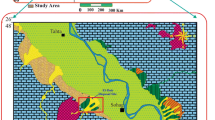Abstract
In order to investigate the groundwater contamination by solid waste disposal using both hydrochemical and geophysical methods, the Halkalı (I˙stanbul) solid waste disposal site which was closed in 1994 was investigated. The disposal site lies on a ridge between two valleys filled with alluvium. A total of six boreholes were drilled on two lines across the Menekşe valley adjacent to the Halkalı site. Groundwater samples collected from these boreholes were analyzed for various contaminant parameters. The results indicate that TDS and chloride concentrations decrease horizontally away from the waste site whereas they increase with depth. Electrical soundings carried out at 12 locations yielded high resistivity values at the upstream part of Menekşe valley while lower values were obtained from the locations near the leachate seepage points.
Similar content being viewed by others
Author information
Authors and Affiliations
Additional information
Received: 11 November 1997 · Accepted: 23 February 1998
Rights and permissions
About this article
Cite this article
Kayabalı, K., Yüksel, F. & Yeken, T. Integrated use of hydrochemistry and resistivity methods in groundwater contamination caused by a recently closed solid waste site. Environmental Geology 36, 227–234 (1998). https://doi.org/10.1007/s002540050339
Issue Date:
DOI: https://doi.org/10.1007/s002540050339




